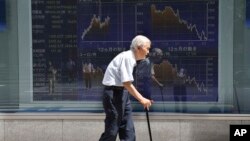Asian countries have leveraged their young populations to produce massive economic gains in recent decades, but their citizens are growing older, posing new challenges for governments.
By 2030, the number of elderly people in Asia is forecast to increase by 200 million, a more than 70 percent increase in contrast to a 31 percent rise in Europe and 55 percent increase in North America.
That will mean a rise in healthcare costs, pressuring government budgets.
Marsh and McLennan companies’ Asia Pacific Risk Center (APRC) estimates the cumulative cost of elderly healthcare in Asia over the next 15 years could reach $20 trillion.
Mika Marumoto, executive director of the Asian Forum of Parliamentarians on Population and Development (AFPPD) says governments need to be more responsive to the depth of the changes needed to deal with the demographic shifts.
"Each government really needs at the national level their aging pace and that absolute number of their aging population they are going to have and then they have to figure out how to help in the most sustainable and also efficient way," Marumoto told VOA.
Wolfram Hedrick and Jonathan Tan, senior directors for Asia Pacific Risk Center in Singapore, in a recent commentary said rising healthcare costs could threaten future growth in the world's major economic engine.
"Elderly healthcare represents a significant fiscal health risk all across Asia,” they said.
Becoming 'aged societies'
The Asian Development Bank (ADB) says a rise in public expenditure is “particularly dramatic in East Asia” where spending in China is set to rise over 50 percent by 2050 due to rapid aging combined with “relatively high rates of economic growth.
Korea is also showing similar spending increases “in large part due to population growth.”
Keizo Takemi, a member of Japan’s House of Councilors and chair of a committee on global health strategy, told a recent conference on aging in Hanoi of the anticipated expansion in demand for healthcare services for the elderly among Asia’s middle- and low-income countries.
Takemi said in Korea, Taiwan, China, Thailand and Sri Lanka, the aging populations had “advanced rapidly from 2000 on. These countries are forecast to become aged societies with elderly populations of 14 percent or more by 2016-2026.”
Similar trends, he noted, were also evident in Vietnam, Indonesia, Myanmar, Kazakhstan, and Iran, divided between rapidly aging and slowly aging populations.
But Malaysia, Cambodia, Laos, India and Mongolia are among the countries whose populations will continue to age slowly, he said.
Japan is already facing the challenges of adapting to an older population. Some 32 percent or 41 million of Japan’s 127 million population is over 60 years old.
Economic impact
ADB senior economist Donghyun Park said for Asia, known for its "Tiger" economies in the 1980s and 1990s, aging populations are impacting economies.
“The issue is that, and it is well known, that less favorable demographics is a negative for growth, it’s harmful for growth, so immediately there will be a negative impact on Asia’s growth,” Park told VOA.
Asia’s substantial “demographic dividend” – of a young working population as a driver of the region’s economic success, buoyed by sound institutions and positive government policies, paid off.
But China is a key example of a country where a rapidly aging population threatens to undermine the economic gains of recent decades.
“Unfortunately, that [demographic] dividend is coming to an end. In other words, in some countries already – not just these very high income countries such as [South] Korea, Singapore and Taipei, China and Hong Kong – rich countries – in which are demographic crisis is a here and now problem, but even in middle income countries such as China,” Park said.







